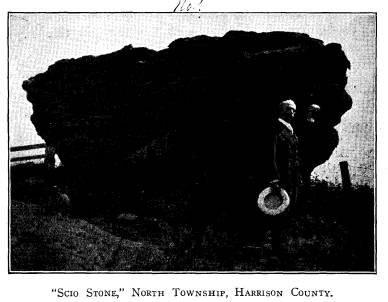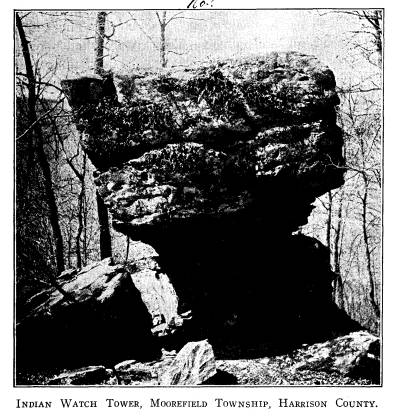Ohio History Journal
THE PILLARS OF HARRISON COUNTY
BY JOSEPH T. HARRISON
There are three native pillars of
stone, in Harrison
County, Ohio, which, if their age is
reckoned from
the date when they first reared their
heads above the
surrounding landscape, are older than
Rome, older than
the Pyramids, and older than the Sphinx
itself.
They are located in the north, central,
and southern
parts of the county, the first two on
the tops of hills and
the third well down from the top of the
adjacent hill,
and appear to be portions of a
continuous stratum of
said rock that spread above the entire
present surface
of the county. If this be true, the
present inhabitants
of the county are all living in
basements of what was
formerly the land surface of Harrison
and Carroll
Counties. The stratified structure of these pillars
shows that they have never been
disturbed by anything
to move them from their present
location since they
were formed. They consist of nothing
but water de-
posited sand in regular layers.
They stand erect like pillars, and had
not the des-
ecrating hand of the white man removed,
from the top
of the first two, about eight feet for
building purposes,
their present height would be about
twenty feet. Their
present isolated character is as much
shown by the
erosion and the wearing away of the
remainder of the
parent stratum in the great age of
their existence, as
the teeth that remain in the human jaw,
when the
neighboring teeth have disappeared, and
the gums have
(120)
|
The Pillars of Harrison County 121 shrunken away. They are simply the hard and per- sistent portions of that rock which were also favored in their location and permitted to stand in their original position. The best known of these is Standing Stone, about one mile west of Cadiz, on the Hedge farm in the north- east quarter of section 11, Cadiz Township, just north of the old Indian Trail, afterwards known as the Mo- |
|
|
|
ravian Road, traversed by the early settlers of Gnadden- hutten, in Tuscarawas County, the murder of whose Indian converts in the stockade, in 1782, was the foulest blot upon the reputation of the white race in this country. Another is on the Woods farm, about two miles northeast of Scio, in the northeast quarter of section 27, North Township, now owned by Solomon Albaugh, |
122 Ohio Arch. and Hist. Society Publications
in the north edge of the county, and in
full view on the
left of the road leading from Scio to
Kilgore, just after
you pass the junction of the road that
leads to New
Rumley (the birthplace of General
Custer), and is on
the top of about as high a hill as
there is in the
vicinity.
The third is in the southwestern part
of the county,
about three miles northeast of
Moorefield, section 6,
in Moorefield Township, and about one-fourth
mile
north of the old Nottingham Church, on
the T. R.
Crawford farm.
A popular error about these solitary
pillars of
sandstone has long obtained, and it is
my purpose to
give what, I believe, is a better
explanation. Henry
Howe says in his Historical
Collections of Ohio:
"About one and one-half miles west
of Cadiz, on the
northern peak of a high sandy ridge,
are the remains of what
is called 'standing stone,' from which
a branch of Stillwater de-
rived its name. The owner of the land
had quarried off its
top some eight feet. It is sandstone,
and was originally from
sixteen to eighteen feet high, about
fifty feet around its base,
and tapered from midway up to a
cone-like top, being only about
twenty feet around near its summit. It
is said to have been a
place of great resort by the Indians,
and its origin has been a
subject of speculation with many
people. It is, however, what
geologists term a boulder, and
was brought to its present position
from, perhaps, a thousand miles north,
embedded in a huge
mass of ice, in some great convulsion
of nature, ages since."
Such an error should not be allowed to
go uncon-
tradicted, and one cannot help feeling
that it was little
less than sacrilege to remove the tops
of these stones
or to deface them in any way. If they
had been "em-
bedded in a huge mass of ice," the
consequent stress
and strain would have destroyed their
stratified struc-
ture; nor could it be explained how
such a cause would
The Pillars of Harrison County 123
have put them down in their present
locations in perfect
alignment with the underlying stone
strata, its own
strata perfectly preserved, and in
close proximity to
disintegrated sandstone material of
similar character.
Southeastern Ohio was not affected by
glacial ac-
tion. A glance over the hills of
Harrison County shows
the tops to be on nearly the same
level. The county
comprises high land, which makes a
watershed between
the short streams that run eastwardly
and directly to
the Ohio River, and the head waters of
Connotton and
Stillwater Creeks, which flow
westwardly to the Tus-
carawas River, and thence into the
Muskingum and the
Ohio at Marietta.
The present broken surface of hills and
valleys com-
prises simply the under side of a
higher plain, and these
pillars we now see are simply the roots
or bases of still
older and higher hills. This broken
surface of hill and
valley is no more than the small
elevations and gutters
in a grain field after a hard rain, but
they are on a larger
scale, the result of the errosive
action of the centuries.
The remains of the Glacial Era are
found in the fringe
of deposits of earth and granite stone
(moraines) ex-
tending northeastwardly from Cincinnati
to Ashtabula,
with a great terminal moraine below and
near Cincin-
nati. Our oldest hills of this state
are to be found in
eastern Ohio. The period for natural
erosion was much
longer in that locality and commenced
long before the
glacial era. The deep valleys of the
Ohio and Mus-
kingum Rivers are notable examples.
The undisturbed location of these
"pillars" upon
high hills and long protected by the
forest has saved
them from the undermining and
disintegrating causes
|
124 Ohio Arch. and Hist. Society Publications which have carried away the remainder of the parent ledge, which then crossed the present valleys in their vicinity. Had the parent stratum of rock, of which they were once part, remained, there would now be seen many natural bridges of stone crossing the adjacent |
|
|
|
valleys, but when its foundations were gone, the sand- stone easily crumbled and fell. The rock and land ad- jacent to these pillars of sandstone on the present hills have worn and shrunken away and left them as natu- rally as a human gum may shrink from a tooth, and |
The Pillars of Harrison County 125
leave it apparently longer than in the
early life of the
individual. Indeed, upon the hillsides
near these stone
may be seen the disintegrated portions
of this ancient
stratum of sandstone. The layers of
sandstone may
now be seen in these ancient pillars as
distinctly as one
may count the layers of a jelly cake.
And they have
the same natural dip towards the south
and east as the
Berea sandstone, the oil bearing rock,
which now lies
1100 feet below, but comes to the surface
at Berea in
the northern part of the state.
In many of the valleys may still be
seen broken
portions of lower rock strata,
scattered along the
hillsides of Connotton and Stillwater
Creeks and
their branches, which have rolled down
to lower levels.
Remnants of the parent ledge may be
seen sticking out
of the eroded hillsides.
These permanent portions are nearer the
tops of the
hills in the northern part of Harrison
County and those
of Carroll County which adjoins it on
the north, than
that of the Nottingham stone in the
south, and shows
about the natural dip of the strata of
the south and east.
The Nottingham stone is newer. Its top
was exposed
at a later date. The superimposed earth
and rock were
eroded away at a later period.
The photograph of the Scio Stone on the
Woods
farm shown in the illustration was
taken September 2,
1920, by Mr. J. A. McKay, of Cleveland,
Ohio. It
shows the outlines, stratified form and
fallen particles
around it. It is about ten feet high,
and on the top
its greatest length and width are
eighteen and twelve
feet respectively. The figure of the
writer in the picture
shows its relative height.
126 Ohio Arch. and Hist.
Society Publications
The one at Cadiz, Standing Stone, shows
thinner
layers of strata. It is about twelve
feet high and its
greatest length and width on top are
sixteen by eighteen
feet.
On September 3, 1920, we also saw the
one near
Moorefield and the old Nottingham
Church. Its photo
was taken in October, 1917, by William
F. Compher, of
Moorefield, Ohio, and the pillar is
locally known as the
Indian Watch Tower. It is about
eighteen feet high,
ten by ten feet on top, and stands on a
slender base
that cannot be over four by five feet.
The greatest pro-
jection is towards the front, and the
mass is so great
above it that in time the whole rock
will fall in this
direction.
It is located on a hillside in a woods,
at an altitude
of about fifty feet below the top of
the nearest hill.
Large portions of the same ledge lie
around it, and
ferns, moss, flowers and vines almost
cover the top.
There is such a similarity between the
Scio and
Cadiz pillars in color, strata,
position and texture, that
they doubtless belong to the same
ancient ledge of sand-
stone that once overlaid the country.
Both show the
presence of iron, both alternate in
color from the light
yellow of common sand to that of brick
dust; both are
on the tops of high hills, and both are
in grassy fields,
with no traces of the parent ledge
about them, except
what may be found beneath the surface
near the Cadiz
stone, for stone of the same character
has been quarried
just beneath the surface in its
vicinity. Not so with the
Scio stone, for it stands on its
original foundation on
a peak of a hill and all remains of the
parent ledge are
|
The Pillars of Harrison County 127 gone. They are the oldest "twin brothers" in all the county,-the oldest perhaps in Ohio. They are so old and their sides so eroded that the softer parts have the appearance of having been eaten into holes, while the iron and harder parts still maintain a stout resistance to the "tooth of time." If we could unroll the scroll of their history, what a wonderful story they would tell. |
|
|


